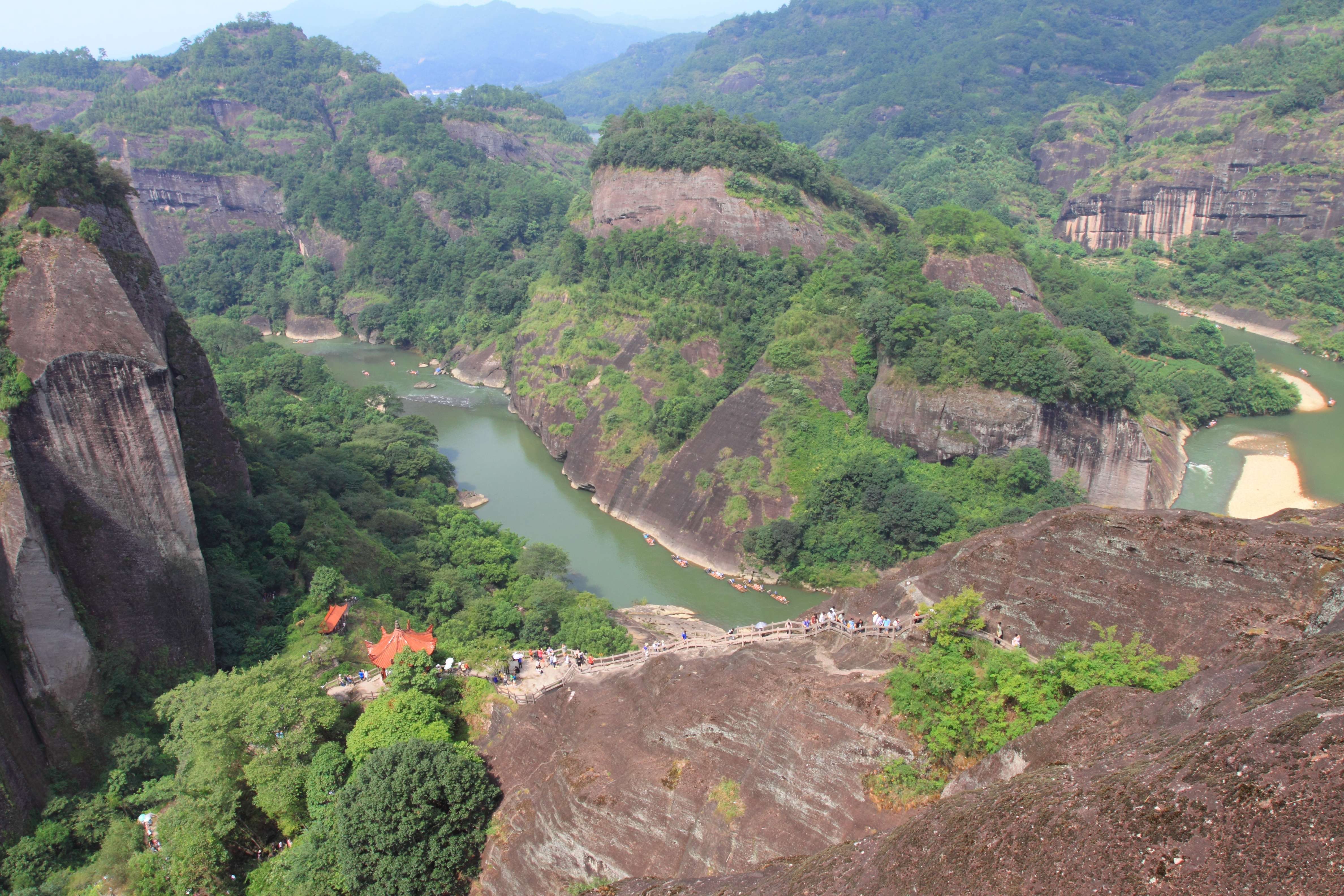|
Shiniuzhai National Geological Park
Shiniuzhai National Geological Park or Pingjiang Shiniuzhai Geopark (石牛寨) is located in Hunan, in Pingjiang County. It is 46 km away from the nearest city of Pingjiang. Shi Nui Zhai is 523 meters above sea level, and occupies a radius of more than 10 square kilometres. It is one of the protected areas of China. Shiniuzhai National Geological Park History The origins of the name Shi Niu Zhai come from the boulder that resembles a cattle in the west part of the park. Shi Nui Zhai used to be an important place for military affairs. According to a historian in the western province, Shi Niu Zhai is the last remaining shanzhai of the 48 in Liuyang. Geography Shi Niu Zhai is a national park that is made up of mainly Danxia landform The Danxia landform () refers to various landscapes found in southeast, southwest and northwest China that "consist of a red bed characterized by steep cliffs". It is a unique type of petrographic geomorphology found in China. Danxia lan ... [...More Info...] [...Related Items...] OR: [Wikipedia] [Google] [Baidu] |
Hunan
Hunan (, ; ) is a landlocked province of the People's Republic of China, part of the South Central China region. Located in the middle reaches of the Yangtze watershed, it borders the province-level divisions of Hubei to the north, Jiangxi to the east, Guangdong and Guangxi to the south, Guizhou to the west and Chongqing to the northwest. Its capital and largest city is Changsha, which also abuts the Xiang River. Hengyang, Zhuzhou, and Yueyang are among its most populous urban cities. With a population of just over 66 million residing in an area of approximately , it is China's 7th most populous province, the fourth most populous among landlocked provinces, the second most populous in South Central China after Guangdong and the most populous province in Central China. It is the largest province in South-Central China and the fourth largest among landlocked provinces and the 10th most extensive province by area. Hunan's nominal GDP was US$ 724 billion (CNY 4.6 trillion) a ... [...More Info...] [...Related Items...] OR: [Wikipedia] [Google] [Baidu] |
Pingjiang County
Pingjiang County () is a county in the northeast of Hunan province, China. It is the easternmost county-level division of the prefecture-level city of Yueyang. The county is located on the eastern margin of the province, the Miluo River runs through the county from east to west. It is bordered to the north by Yueyang County, to the west by Miluo City, to the south by Changsha County and Liuyang City, to the east by Xiushui and Tonggu Counties of Jiangxi Jiangxi (; ; formerly romanized as Kiangsi or Chianghsi) is a landlocked province in the east of the People's Republic of China. Its major cities include Nanchang and Jiujiang. Spanning from the banks of the Yangtze river in the north int ..., to the northeast by Tongcheng County of Hubei. Pingjiang County covers an area of , as of 2015, it had a registered population of 1,106,900 and a permanent resident population of 979,300. The county has 19 towns and 5 townships under its jurisdiction. The government seat is Ha ... [...More Info...] [...Related Items...] OR: [Wikipedia] [Google] [Baidu] |
List Of Protected Areas Of China
This is a list of the nationally-designated protected areas of China. There are many forms of protected areas in China. Based on their relative importance, each type of protected area can be further graded into two to three levels (national, provincial and prefectural/county level). Nevertheless, the highest rank for "pocket nature preserve" (social and mass-based), "no-hunting area", "no-fishing area", "no-logging area", "wild medicinal material resources conservation area", "crop germplasm resources conservation area", "forest tree germplasm resources conservation area" or "source water protection area" is practically restricted to provincial level. The local government at county level is also responsible for the delimitation and declaration of "basic farmland protection area" and "basic grassland". Take note that many protected areas in China have multiple official designations, and the statutory boundaries of these multi-designated PAs may be identical or may vary one from ... [...More Info...] [...Related Items...] OR: [Wikipedia] [Google] [Baidu] |
Shanzhai
''Shanzhai'' () is a Chinese term literally meaning "mountain fortress" or "mountain camp", whose contemporary use usually encompasses counterfeit, imitation, or parody products and events and the subculture surrounding them. ''Shanzhai'' products can include counterfeit consumer and electronic goods, which can involve the imitation and trademark infringement of brands and companies. The term's modern usage grew around 2008 when counterfeit smartphones reached their greatest domestic use. Today, some relate the term with grassroots innovation and creativity rather than with falsehood or imitation. Origin The term ''shanzhai'' was first used for its literal meaning, which referred to defensible mountain forts and strongholds, usually in areas on the outer reaches of imperial government control. During the Song dynasty (960–1279), ''shanzhai'' came to describe groups of bandits who opposed and evaded the corrupt authorities to perform deeds they saw as justified. One of the most ... [...More Info...] [...Related Items...] OR: [Wikipedia] [Google] [Baidu] |
Danxia Landform
The Danxia landform () refers to various landscapes found in southeast, southwest and northwest China that "consist of a red bed characterized by steep cliffs". It is a unique type of petrographic geomorphology found in China. Danxia landform is formed from red-coloured sandstones and conglomerates of largely Cretaceous age. The landforms look very much like karst topography that forms in areas underlain by limestones, but since the rocks that form danxia are sandstones and conglomerates, they have been called "pseudo-karst" landforms. They were formed by endogenous forces (including uplift) and exogenous forces (including weathering and erosion). The first studies on what are now referred to as Danxia landforms were conducted at Mount Danxia near Shaoguan, China. In the 1920s and 1930s Chinese geologists made an effort to learn more about these interesting geomorphic structures. Danxia landforms are made up of uplifted continental crust that has been faulted and eroded, exposing ... [...More Info...] [...Related Items...] OR: [Wikipedia] [Google] [Baidu] |
Zhangjiajie Glass Bridge
Zhangjiajie Glass footpath is a skywalk bridge in Zhangjiajie, Hunan, above the Wulingyuan area. The bridge, built as an attraction for tourists, is glass-bottomed and is transparent. When it opened it was the longest and tallest glass bottomed bridge in the world. The bridge, opened to the public on August 20, 2016, measures in total length and in width, and is suspended about above the ground. The bridge spans the canyon between two mountain cliffs in Zhangjiajie National Forest Park in the northwest of Hunan province. It is designed to carry up to 800 visitors at a time. The bridge was designed by Israeli architect Haim Dotan. To build the bridge, engineers erected four support pillars on the edges of the walls of the canyon. The bridge is made of a metal frame with more than 120 glass panels. Each of these panels is three-layered and is a slab of tempered glass. There are three long swings attached to the underside of the bridge. There is also a provision for making a bu ... [...More Info...] [...Related Items...] OR: [Wikipedia] [Google] [Baidu] |
Yueyang
Yueyang, formerly known as Yuezhou or Yochow, is a prefecture-level city on the eastern shores of Dongting Lake and Yangtze in the northeastern corner of Hunan Province in the People's Republic of China. Yueyang has an administrative area of and the city proper, . The population was 5,051,922 at the 2020 Chinese census whom 1,134,058 lived in the built-up (or metro) area made up of Yueyanglou District and Yunxi District, Junshan District not being conurbated. Yueyang is the only international trade port city in Hunan and a famous port city in China, at the same time, Yueyang's comprehensive economic strength ranks of Hunan second only to Changsha, the provincial capital. The city's most famous attractions are the Yueyang Tower and Dongting Lake. The most famous food is Dongting lake silver fish (). In 2021, the city's permanent resident population was 5,051,922, a decrease of 424,162 from the end of last year. Administration The Yueyang prefecture is made up of six outlyin ... [...More Info...] [...Related Items...] OR: [Wikipedia] [Google] [Baidu] |

